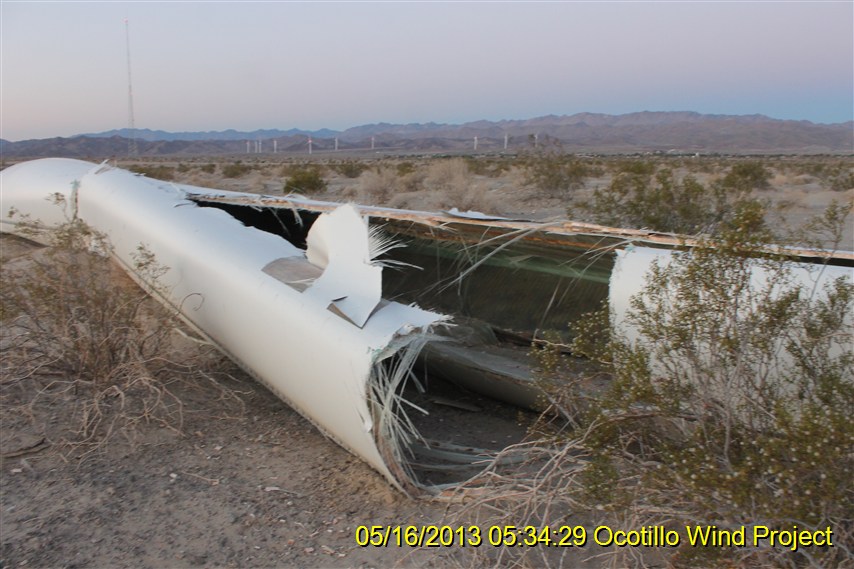You’ll remember “Prowind” breaking the silence over, what was, the best kept secret in Defence circles: that giant wind turbines are being deployed as weapons of mass destruction.
Commenting on our piece Life in the “throw zone”, Prowind told us that the dozens of recorded “blade throw” events were “not accident”; and that turbine owners were “purposely” causing giant turbines to explode into a shower of steel and fiberglass shrapnel, spread over thousands of metres.
Well, it seems that the work on these new weapons of mass destruction is running apace.
One of our operatives intercepted this communication on the latest experiment by the US Department of Defence. So stop worrying about IWTs and start worrying about the roll out of WMDs, as Siemens looks like it’s hell bent on making the top 10 weapons manufacturers’ list.
Ocotillo Wind Turbine Throws Off Multi-Ton Blade, Prompting World-Wide Shut Down of Similar Turbines Amid Growing Safety Concerns
East County Magazine
May 17, 2013 • California
Miriam Raftery (Sierra Robinson, Sholeh Sisson and Jim Pelley)
One day after San Diego Supervisors ignored residents’ safety concerns and approved a wind ordinance that would open much of East County to industrial wind turbines, a wind turbine at the Ocotillo Express Wind Energy facility hurled off an 11-ton blade. The blade, manufactured by Siemens, landed on a trail used by off-road vehicles. The accident has shut down the wind facility pending investigation into the cause.
An investigation by East County Magazine (ECM) reveals a dark history of serious safety hazards involving Siemens’ wind products as well as a corporate past that includes guilty pleas to corruption on a global scale, including accusations of bribery and other serious charges in at least 20 nations.
Siemens contracted with Pattern Energy, a company with its own checkered corporate past, as ECM has previously reported, to build the controversial project on public land managed by the U.S. Bureau of Land Management in Ocotillo and paid for with taxpayer subsidies. Pattern’s corporate predecessor also built the Kumeyaay Wind project in Campo, which blew apart in 2010, whirling blade parts over the area. All 75 blades on all 25 turbines had to be replaced; the project was off-line for months.
Accident in Ocotillo
ECM photographer and aerospace engineer Jim Pelley discovered the fallen blade before dawn this morning when he looked out from his front porch eastward and saw the enormous blade, which has a span the length of a football field, lying on the desert floor. “It came down on its point and then fell over, about 150 feet from the turbine,” Pelley told ECM.
During the night, wind speeds ranged from 9 to 19 miles per hour, with gusts up to 29 miles per hour. “The blades are supposed to withstand gusts up to 56 miles per hour for up to 10 minutes,” Pelley said.
Pelley and another photographer, Parke Ewing, a former construction manager, advised that workers were attempting to block public access to the site. The two have been documenting construction issues at the site for months and have long warned of a possible turbine collapse or blade failure.
Pelley said the fiberglass blade, filled with wood, pulled free of the mounting assembly and snapped off.
Pattern energy declined to comment on the accident, referring ECM to Siemens. Siemens provided the following statement:
“A B53 rotor blade of a SWT-2.3-108 wind turbine broke off near the blade root and fell to the ground at the Ocotillo Wind project in California. No one was injured.
Siemens Energy has immediately convened a team of experts at the site who will examine all facets of this incident, including the production, installation, commissioning and service of the blade, which is under warranty by Siemens Energy.”
The statement continued, ‘Siemens does not yet know the root cause of this incident and is working to determine if and how this is related to a recent similar incident in Iowa. Today, Siemens is taking the step of curtailing all turbines with the B53 blade type globally. These turbines will remain curtailed until it can be determined they are not at risk of a similar malfunction. As the inspections and analysis progress, Siemens will make further determinations on curtailment protocols.”
Accidents with Siemens blades at other wind projects
ECM found other cases of turbine collapses and blade failures involving Siemens equipment. In March 2010, a Siemens blade snapped off at Scotland’s largest wind farm, bringing the facility to a halt. In 2008, a Siemens turbine in Oregon collapsed, killing Chadd Mitchell, a worker who was also a young father and military veteran. Siemens paid a $10,500 fine. In April 2010, a blade snapped off a Siemens 2.3-108 turbine in Iowa. That’s the same model as the turbines in Ocotillo that lost a blade this morning.
Siemens recently exited the nuclear business after the Fukushima meltdowns. The company has had its own share of problems with its nuclear products including turbine blades that snapped off at a Michigan nuclear plant.
East County Magazine
Of course, as Prowind says, this “is NEVER going to happen at Macarthur”. But as Mr Bond once said: “Never say never” …….
WARNING: to the mentally challenged, greentards and eco-fascists THIS SITE CONTAINS HUMOUR.
HUMOUR including but not limited to “SATIRE”, “PARODY”, “IRONY” and good ol’ “SARCASM” – and, on occasions, extending to “RIDICULE” and “MOCKERY”. See our post here.
IF YOU HAVE DIFFICULTY WITH ANY OF THESE CONCEPTS PLEASE SEEK ASSISTANCE FROM A GROWN UP OR, IF A GROWN UP FAILS, A MENTAL HEALTH PROFESSIONAL.



The only time you should say never, is when you say, NEVER SAY NEVER. Mr Bond got it right.
The wind mob are going to get caught out very, very, soon with their hip pockets, hosts included.
And we are continually told they are safe!!! With more and more here being erected next to homes and property boundary’s where people are working on non ‘host’ properties, they are being erected next to public roads – yes they are safe – if you are living and working in a town or city and don’t go out into the country. One accident which causes death or injury is one too many.